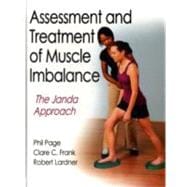
Note: Supplemental materials are not guaranteed with Rental or Used book purchases.
Purchase Benefits
Looking to rent a book? Rent Assessment and treatment of muscle Imbalance : The Janda Approach [ISBN: 9780736074001] for the semester, quarter, and short term or search our site for other textbooks by Page, Phillip. Renting a textbook can save you up to 90% from the cost of buying.
| Structural and Functional Approaches to Muscle Imbalance | |
| The Sensorimotor System | |
| Chain Reactions | |
| Posture, Balance, and Gait Analysis | |
| Evaluation of Movement Patterns | |
| Muscle Length Testing | |
| Soft-Tissue Assessment | |
| Normalization of Peripheral Structures | |
| Restoration of Muscle Balance | |
| Sensorimotor Training | |
| Cervical Pain Syndromes | |
| Lower-Extremity Pain Syndromes | |
| Table of Contents provided by Ingram. All Rights Reserved. |
The New copy of this book will include any supplemental materials advertised. Please check the title of the book to determine if it should include any access cards, study guides, lab manuals, CDs, etc.
The Used, Rental and eBook copies of this book are not guaranteed to include any supplemental materials. Typically, only the book itself is included. This is true even if the title states it includes any access cards, study guides, lab manuals, CDs, etc.